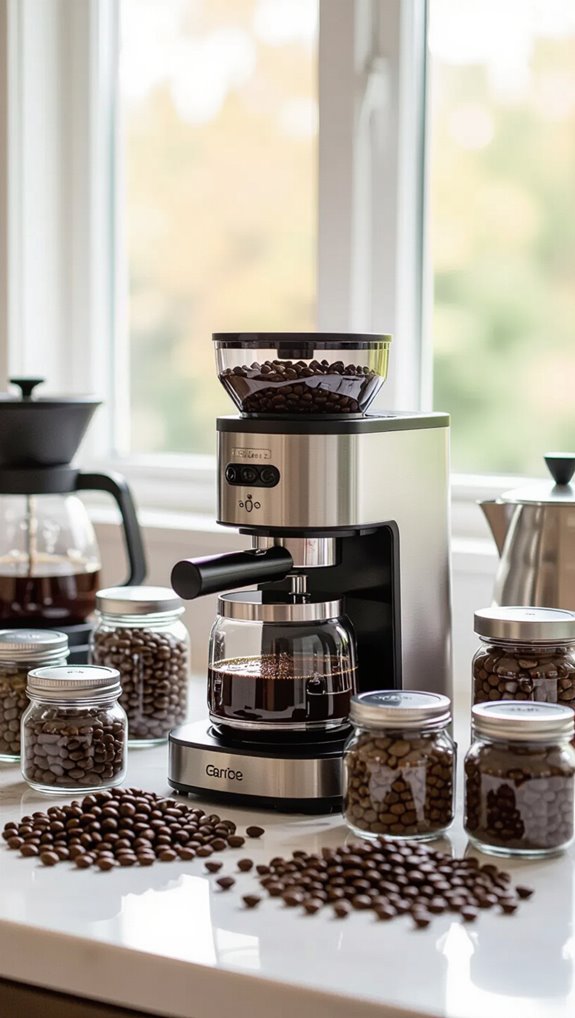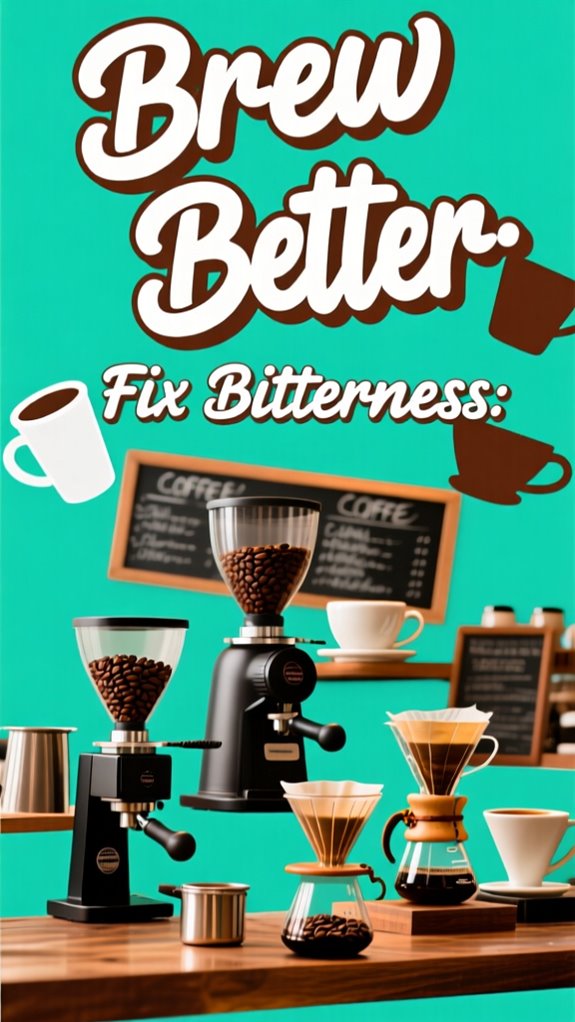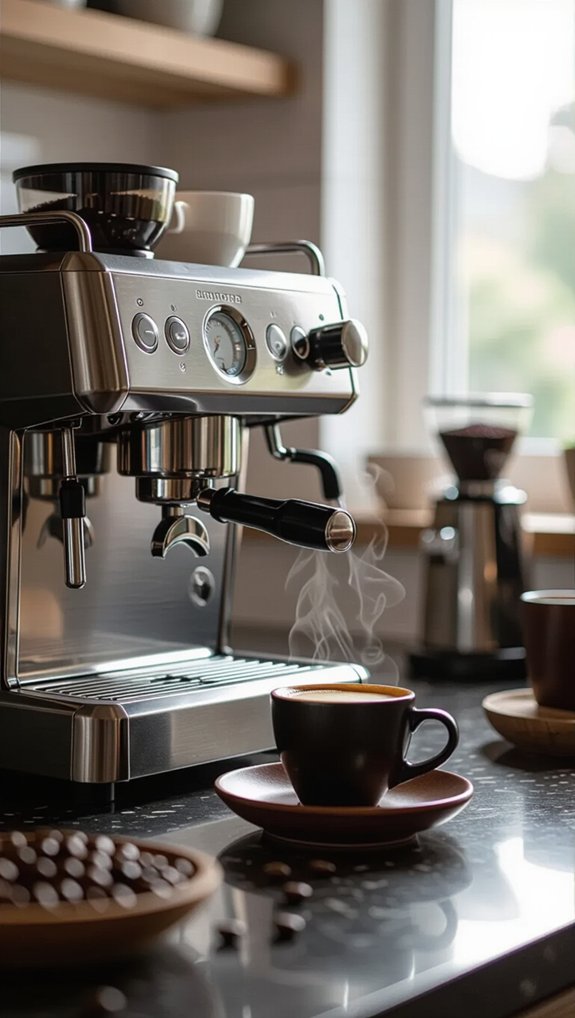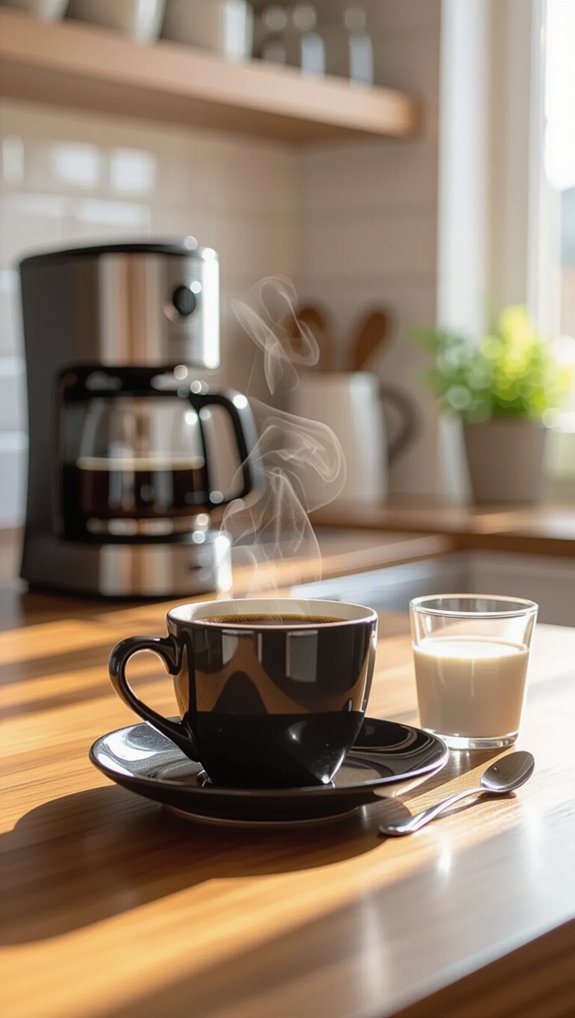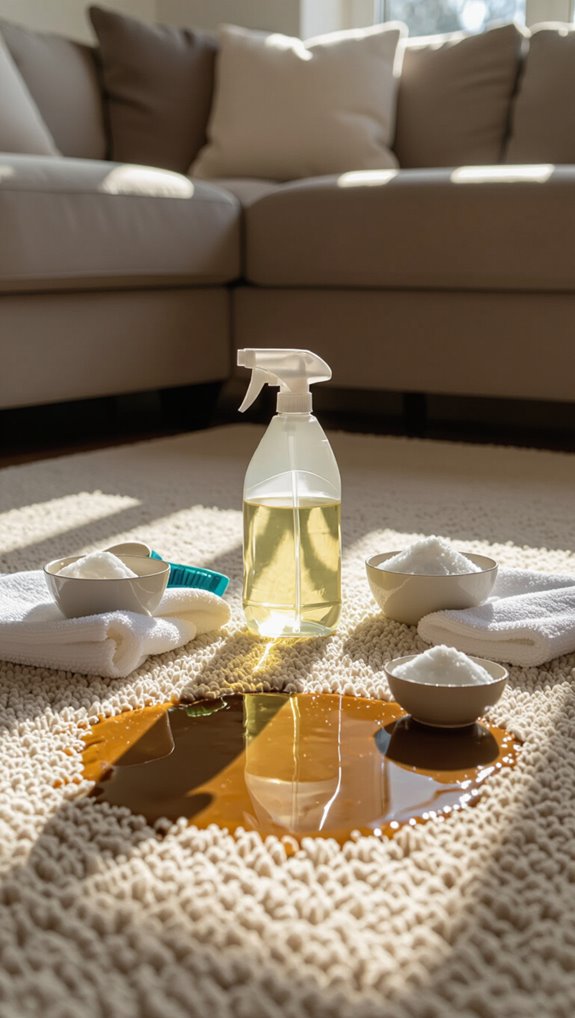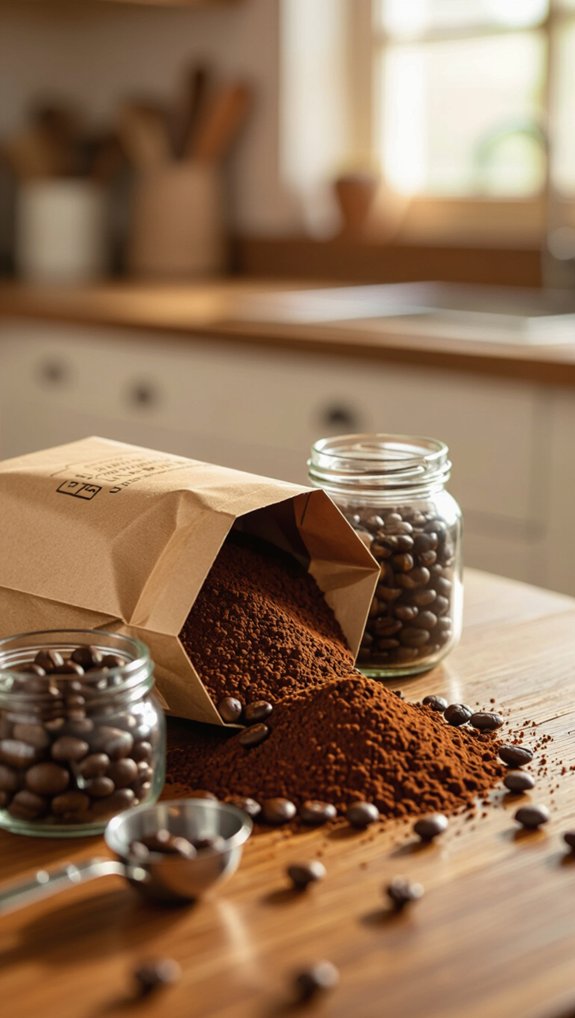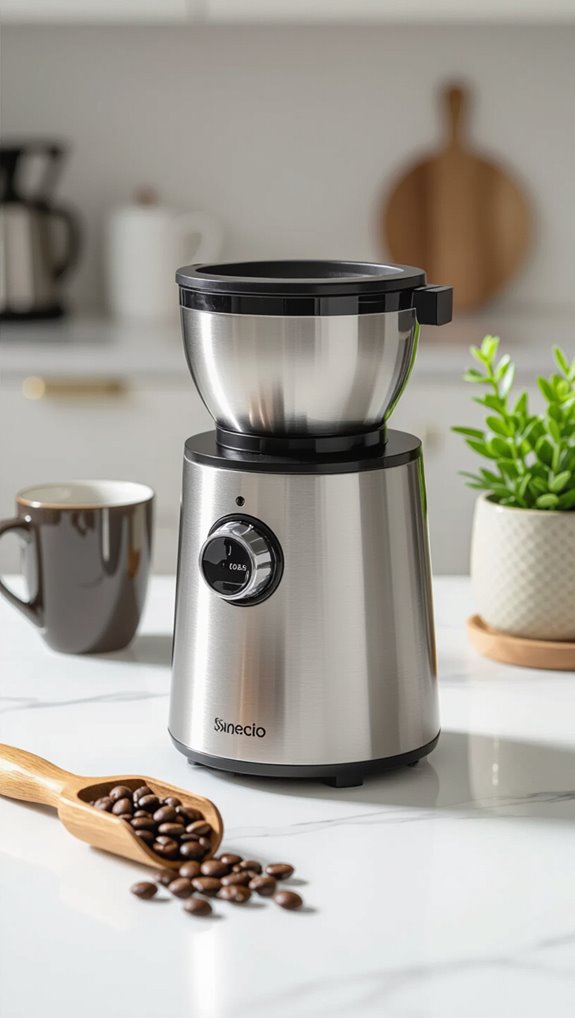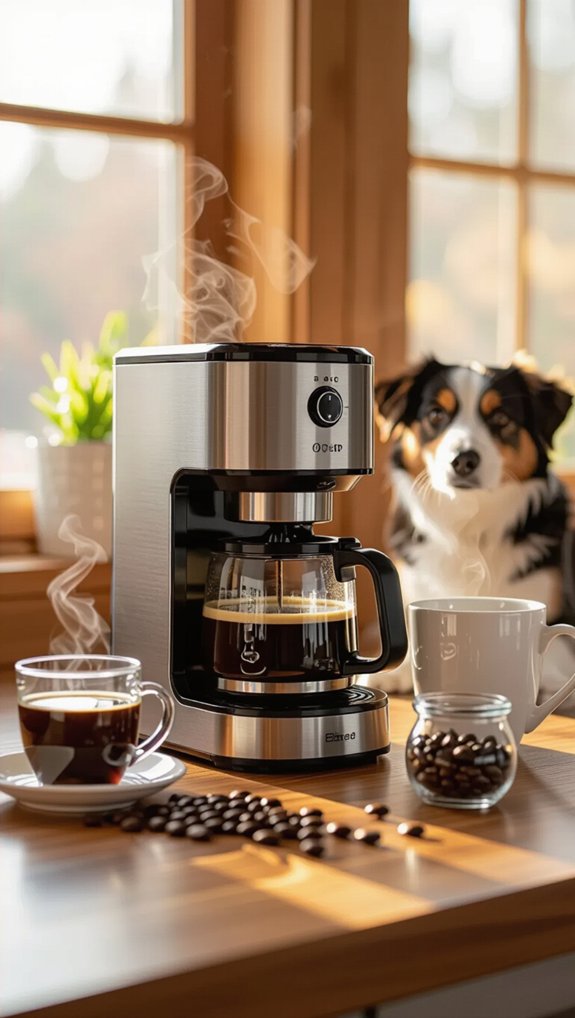Ever wondered why your coffee tastes bitter or sour? The secret lies in your grind size. Your daily disappointment might stem from using the wrong grind for your brewing method—a mistake that turns premium beans into an undrinkable mess.
Think of the coffee grind size chart as your roadmap to brewing perfection. This precise guide matches your grinding texture to specific brewing methods, from French press to espresso. By understanding how different grinds impact extraction, you’ll transform mediocre morning cups into rich, balanced experiences.
This post reveals the science behind grind size and provides a complete chart to fix your brewing problems. You’ll discover which grind works best for each method, how to adjust for taste preferences, and common mistakes that sabotage your coffee quality.
Table of Contents
What is the coffee grind size chart
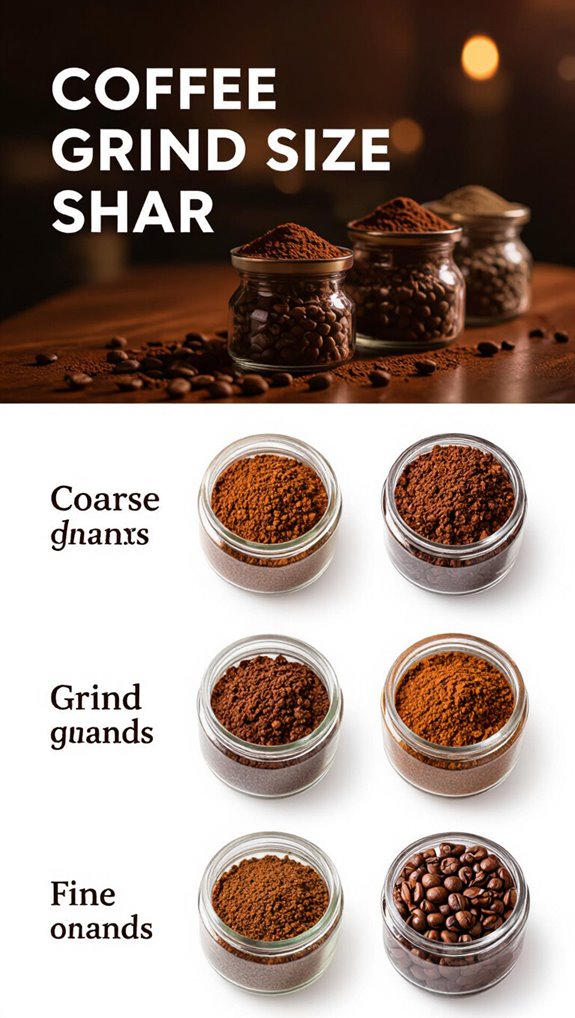
Have you ever wondered how to perfectly match your coffee grind size to your brewing method? A coffee grind size chart is your roadmap to brewing perfection. It maps out Coffee Grind Sizes from extra-coarse (like peppercorns) to extra-fine (like talc), connecting grind size to specific brewing methods.
Each grind level impacts extraction time and flavor: coarse grinds work great for French press, while fine grounds excel in espresso. By tuning grind size, you’ll unlock balanced extraction, preventing bitter or sour brews.
Whether you’re making pour-over or experimenting with different techniques, grasping grind size is key to brewing extraordinary coffee.
Grind size chart quick reference guide
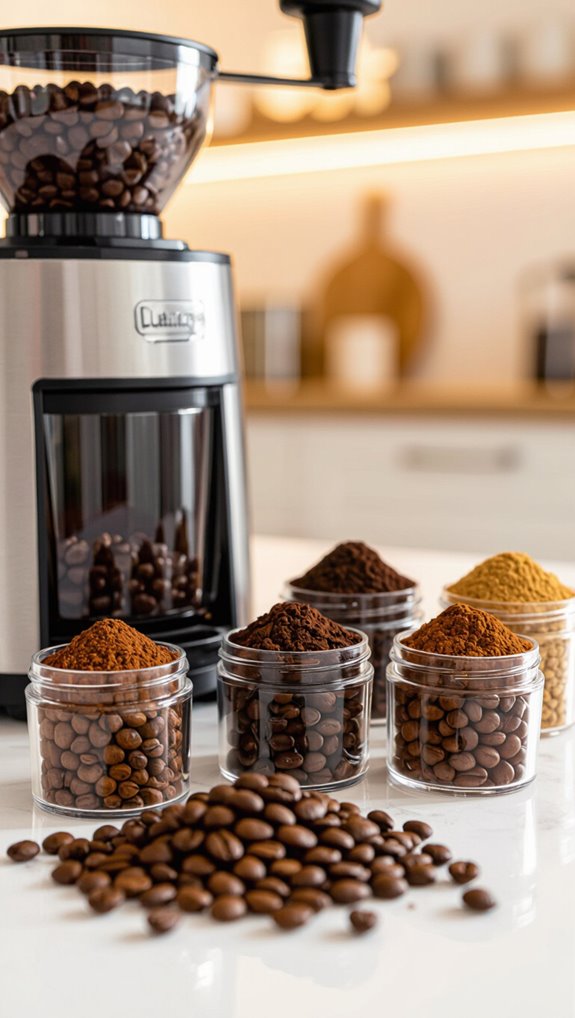
Now that you understand the basics of coffee grind sizes, let me give you the ultimate quick reference guide that’ll transform your brewing game. Check out this essential grind size chart that matches extraction methods to perfect brewing results:
| Grind Size | Brewing Method |
|---|---|
| Extra-Fine | Turkish Coffee |
| Fine | Espresso |
| Medium | Pour-Over |
Each grind size impacts extraction time and flavor profile. Fine grinds work best for espresso, extracting intense flavors quickly. Coarser grinds like those for cold brew allow slower, smoother extraction. Matching grind size to your brewing method ensures a consistently delicious cup every time.
Which grind size for my brewer
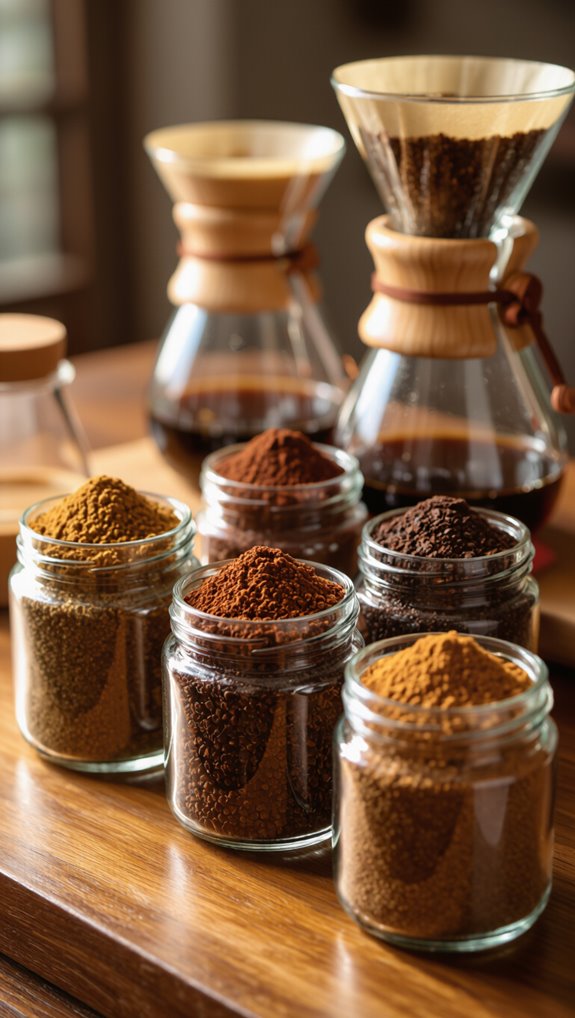
Let’s zero in on matching your brewing method with the perfect grind size—think of it like finding the right key for a lock. Your grind size dramatically impacts flavor, so choosing wisely is crucial.
Espresso demands a fine grind, while French press needs coarse. Pour-over sits nicely in the medium range, allowing balanced extraction. Cold brew requires an extra-coarse setting for its long steeping time.
The rule of thumb? Start with recommended grind sizes, then adjust brew time and particle fineness. Listen to your taste buds—they’re the ultimate guide in dialing in that perfect cup.
How to use the grind size chart
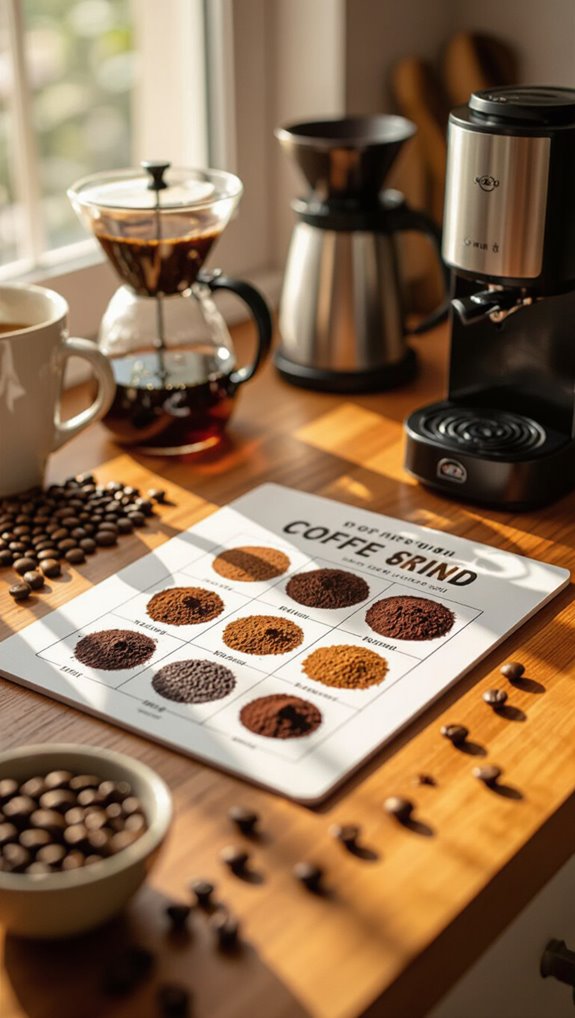
I’ll use the grind size chart as your roadmap to brewing better coffee by matching your brewing method with the right particle size and making precise, incremental adjustments.
Your goal is to use the chart’s recommended starting point—like fine for espresso or coarse for French press—and then systematically fine-tune your technique by tracking brew variables like extraction time, taste, and visual cues.
Ingredients
Because brewing the perfect cup of coffee requires precision, the grind size chart becomes your roadmap to extracting the most delicious flavors from your beans. Your coffee grind size dramatically impacts extraction, bitterness, and overall taste. Match your grind to the brew method: extra-coarse for cold brew, coarse for French press, medium for pour-over, and fine for espresso.
When brewing, change only one variable at a time—grind. Use weight measurements (15g coffee to 250g water) and adjust gradually. If your coffee tastes sour, grind finer; if bitter, grind coarser. Consistency is key.
Equipment
The right equipment transforms your coffee grind size chart from a theoretical guide to a practical brewing tool.
A quality burr grinder is essential for achieving consistent particle size across espresso, pour-over, and French press methods.
Start by selecting a grinder with multiple settings and calibrate it carefully, logging each brew’s parameters.
Maintain your equipment by brushing out grounds daily and deep-cleaning burrs weekly.
Small adjustments in grind size can dramatically improve extraction, turning an average cup into a sublime experience.
Precision and patience are your brewing allies.
Instructions
When navigating the coffee grind size chart, start by identifying your brewing method and matching its unique extraction requirements to the corresponding grind size, ensuring you’ll extract maximum flavor from your beans.
Keep your dose, water temperature (195–205°F), and brew ratio consistent while changing the grind one notch at a time. Track your adjustments meticulously: log grind settings, extraction times, and tasting notes. Listen to your coffee’s flavor profile—if it’s sour, go finer; if it’s bitter, go coarser. Your palate is the ultimate guide to dialing in the perfect brew.
Coffee grind levels and taste notes
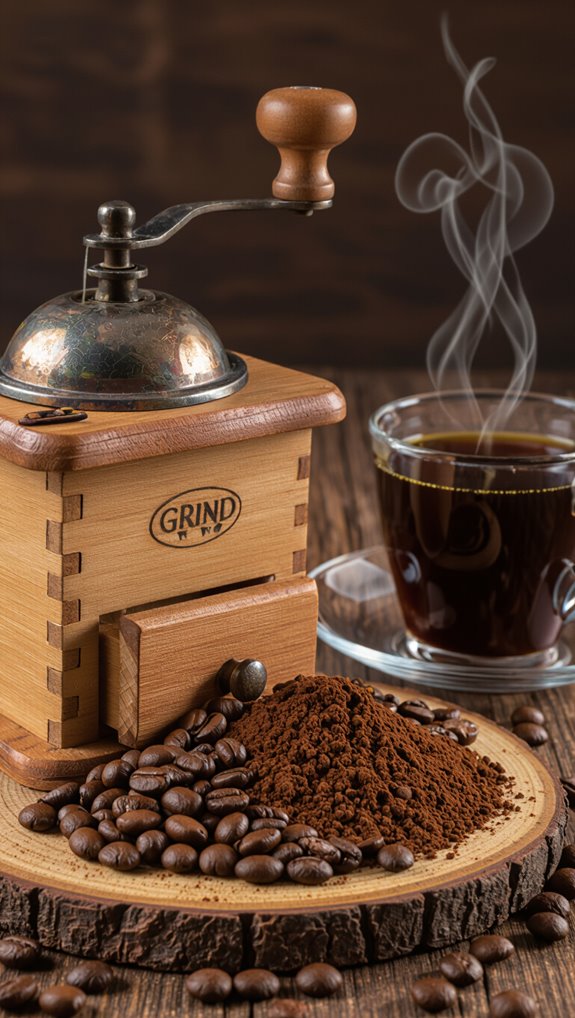
Grinding coffee isn’t just about crushing beans—it’s an art that directly impacts your brew’s flavor profile, with each grind size unlocking different taste dimensions and sensory experiences.
The extraction process varies dramatically based on grind size: extra-fine grinds produce intense, concentrated flavors perfect for espresso, while coarse grinds like those used in French press create smooth, less bitter brews.
Your brew method determines ideal grind size—from Turkish coffee’s powdery texture to cold brew‘s chunky consistency.
Comprehending these nuances helps you dial in perfect bitterness levels, transforming your home brewing from mundane to magnificent.
Espresso grind vs pour-over grind differences
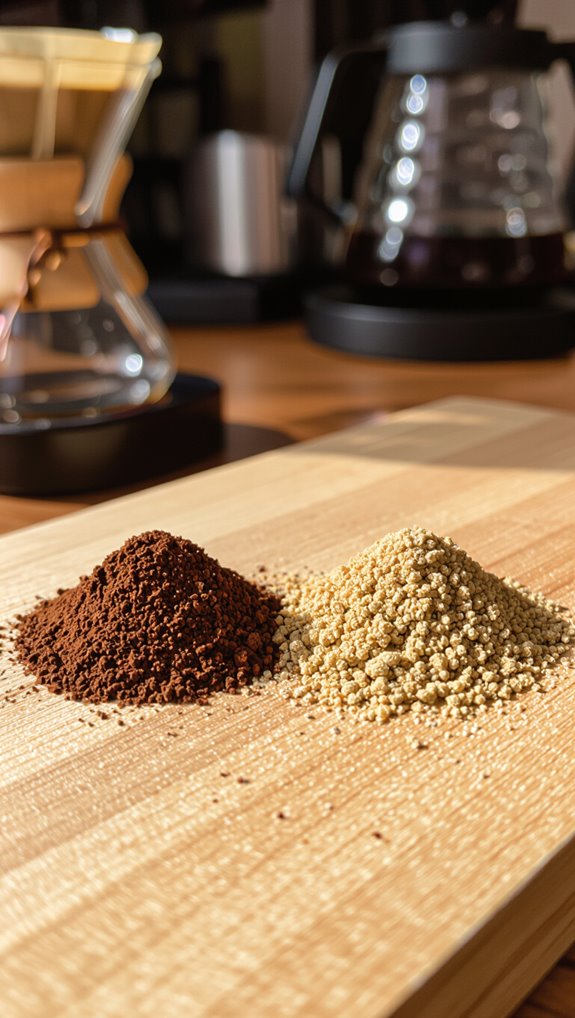
As you explore coffee’s intricate world beyond basic grinding techniques, grasping the critical differences between espresso and pour-over grinds becomes a game-changer for your brewing precision.
Espresso grind is ultra-fine, almost like table salt, designed for high-pressure extraction through a tightly tamped puck in ~30 seconds. Pour-over grinds are coarser, allowing a slower, gentler flow rate over 2-4 minutes.
Mix them up, and you’ll face disaster: espresso grinds in pour-over create bitter, clogged filters, while pour-over grind in espresso yields weak, sour shots. Precision matters.
What grind for French press coffee
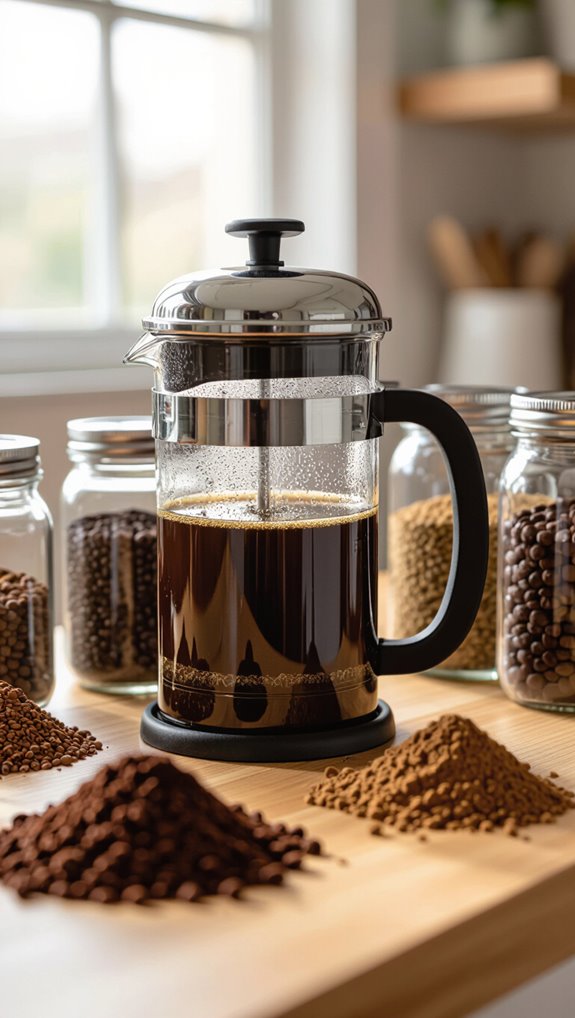
The rustic charm of French press coffee demands a coarse grind that’s as textured as sea salt or breadcrumbs, ensuring a rich, full-bodied brew without the bitter bite of over-extraction.
A coarse grind (1.2–1.5 mm particle size) prevents sediment from slipping through the metal filter and maintains a clean cup.
Start with a 1:15 coffee-to-water ratio, using a burr grinder for uniform particles.
Aim for a 4-minute steep time, and immediately pour off the brew after plunging to stop extraction.
Adjust your grind—slightly finer if weak, coarser if bitter—and you’ll master the perfect French press technique.
Best grind size for cold brew
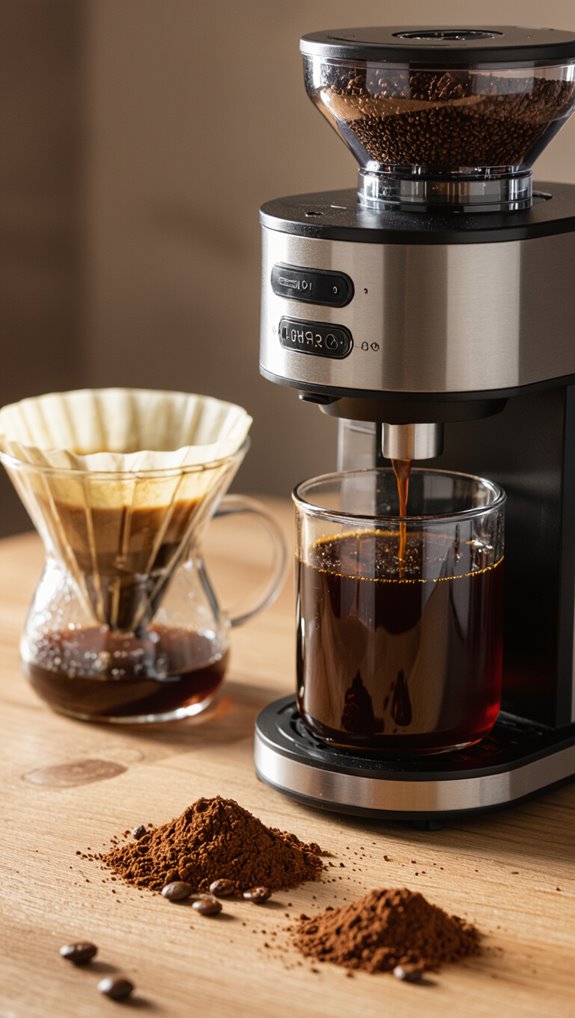
While French press demands a coarse grind, cold brew takes that concept even further into extra-coarse territory. Extra-coarse grounds are crucial for preventing over-extraction during the lengthy 12–24 hour steep time.
Think coffee grounds resembling rock salt or coarse breadcrumbs – this prevents bitter, muddy concentrates by minimizing fines and ensuring smooth filtering.
The ideal cold brew ratio ranges from 1:4 to 1:8 for concentrate. If your brew tastes harsh, coarsen the grind incrementally.
Conversely, if it’s weak, adjust contact time or use a slightly finer grind. Precision matters in crafting that perfect cold brew.
Can grind size fix bitter coffee
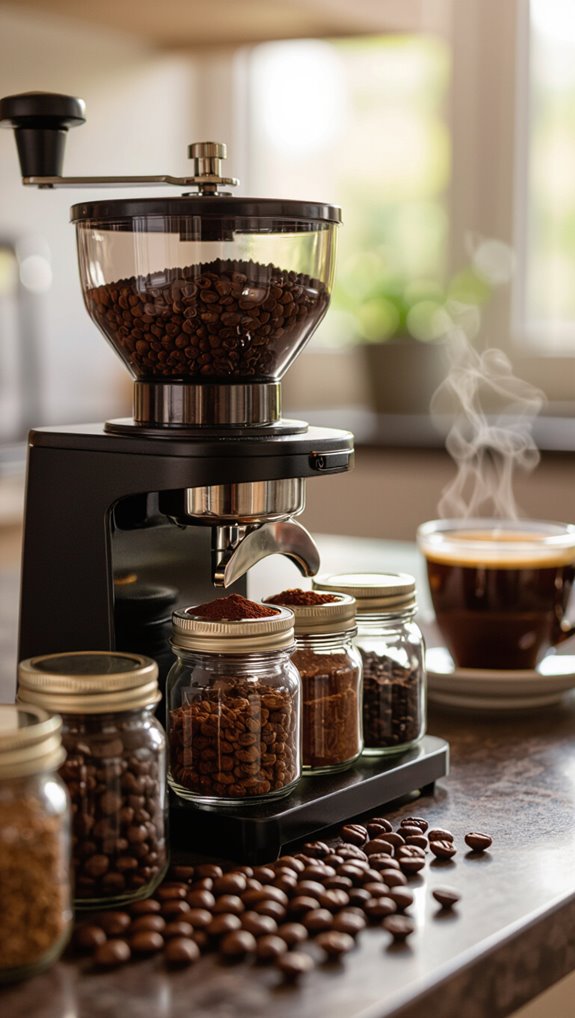
When bitterness hijacks your coffee’s flavor profile, grind size becomes your secret weapon for rescue, offering a precise solution to transform an unpalatable brew into a smooth, balanced cup. Different brewing methods require targeted grind adjustments to combat over-extraction.
| Brew Method | Bitterness Fix | Grind Adjustment |
|---|---|---|
| Espresso | Slow shots | Coarsen 1 step |
| Pour-over | Slow drawdown | Move medium-coarse |
| French Press | Astringent taste | Shift to coarser |
| Cold Brew | Extended steeping | Reduce particle size |
Experiment incrementally, keeping water temperature and other variables constant. A single grind step can dramatically improve your coffee’s flavor, turning bitter disappointment into brewing success.
Dialing in grind with burr settings
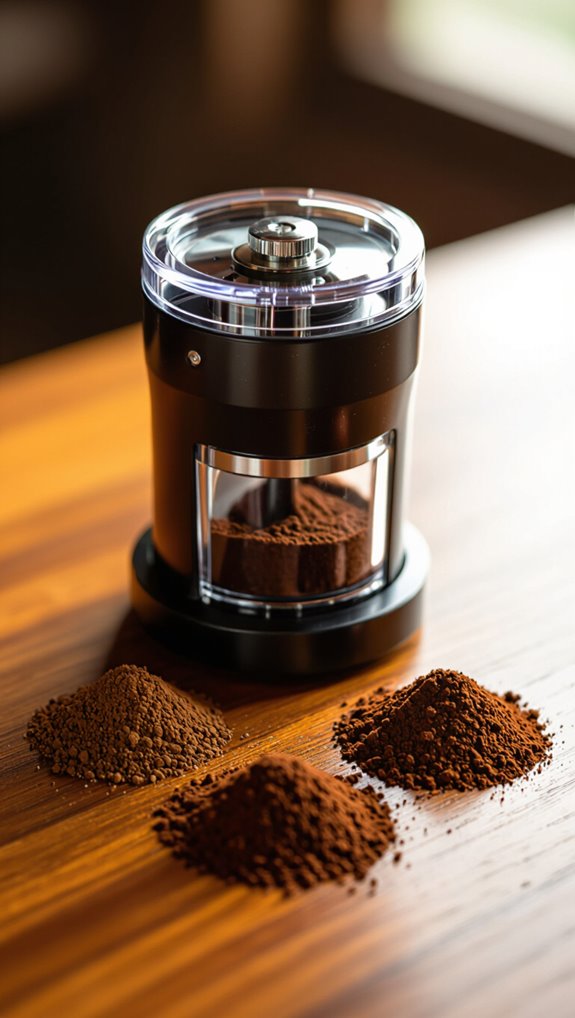
After wrestling with bitter coffee by adjusting grind size, mastering your burr grinder’s settings becomes the next precision skill in crafting the perfect brew.
When dialing in your grind, start from a known setting—typically medium—and change one step at a time.
For espresso, target a 28-32 second extraction with an 18g dose yielding 36-40g. Pour-over and French press have different time targets, but the principle remains: if brew time is fast, go finer; if slow, coarsen the burr setting.
Log each adjustment to track your flavor journey and repeat successful configurations.
Frequently Asked Questions
What Grind Size Makes Coffee Less Bitter?
I’ll reduce coffee’s bitterness by using a coarser grind. This decreases surface area and extraction time, preventing over-extraction. It’s especially effective for drip and immersion methods like French press, helping you brew a smoother, less bitter cup.
What Cancels Out Bitterness in Coffee?
I’ll counteract coffee’s bitterness by coarsening my grind, lowering brew temperature, adjusting coffee-to-water ratio, using fresher beans, and ensuring an even, clean grind from my burr grinder. These techniques soften harsh flavors and improve overall taste.
What Is the 15 15 15 Rule for Coffee?
I use the 15-15-15 rule to brew perfect pour-over coffee: 15g coffee, 15-second bloom, and three 15-second water pours. It helps me control extraction, improve flavor clarity, and create a balanced, delicious cup every time.
Does Coffee Grind Size Affect Taste?
Yes, grind size dramatically affects taste. I’ll determine the right extraction by matching my grind’s fineness to my brewing method, ensuring I avoid bitter or sour flavors and capture the coffee’s optimal, balanced flavor profile.
In Conclusion
Your perfect brew starts with understanding grind size. By matching your coffee grinder’s settings to your brewing method and tasting the results, you’ll transform your home coffee experience. The coffee grind size chart becomes your roadmap to fixing bitterness and brewing better coffee—whether you’re working with a coarse grind for French press or fine grounds for espresso.
Experiment carefully, one tiny adjustment at a time, and you’ll discover how small changes dramatically improve flavor. Remember, brewing great coffee is part science, part art—and totally delicious. To complete your coffee setup, check out our coffee machine reviews to explore smart, well-reviewed options that pair perfectly with your newly mastered grinding techniques. Your taste buds will thank you for the journey.

